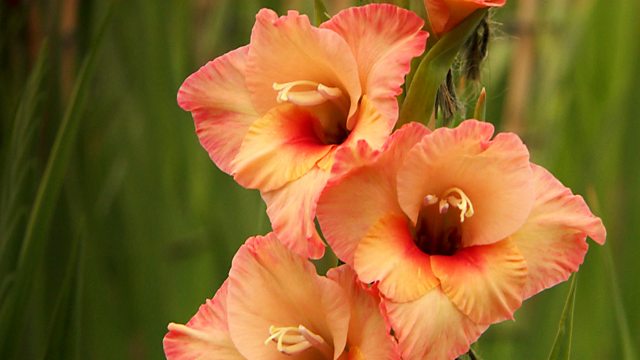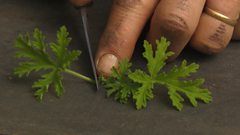
Episode 21
Gardening magazine. Monty Don turns his attention to autumn, tackling the problem of what to grow in the shade of a tree or shrub. Carol Klein takes a closer look at the crocosmia.
As August draws to a close, Monty Don turns his attention to autumn and tackles that perennial problem of what to grow in the shade of a tree or shrub. He also takes cuttings of his favourite pelargoniums - an essential task at this time of year.
Carol Klein takes a closer look at that late summer jewel, the crocosmia, and we meet a gardener in Derbyshire who has spent a lifetime growing and showing gladioli.
Last on
Clips
-
![]()
Crocosmia expert
Duration: 02:48
-
![]()
Pelargonium cuttings
Duration: 03:10
Gladioli

Gladioli are easy to grow. Plenty of sun and a well-drained, fertile soil will keep them happy. On heavy clay, they’re best lifted in the autumn and stored somewhere dry and frost-free. But on light, sandy soil, they can be left in the ground from one year to the next. Many of the gladioli Nigel Coe grows have been specially selected for showing. But he also has a soft spot for those varieties that belong to the Primulinus Group. They are much daintier with smaller flowers and are great for cutting. They’re hard to get hold of these days, however, but Nigel is on a mission to keep them going.
Μύ
(www.britglad.com)
Ferns

Ferns are often overlooked in the garden. But in the shade of a deciduous tree or shrub where nothing else will grow, they’re hard to beat. Competition for food and water is fierce in this situation, but since many of our woodland ferns actually thrive in these conditions, they are perfect for the job. Monty has chosen two of our native ferns to line his shady path at Longmeadow, namely Dryopteris filix-mas (Male fern) and Dryopteris affinis (Scaly male fern). Other suitable candidates include Polypodium vulgare (Common polypody) and Polystichum setiferum (Soft shield fern).
Μύ
Μύ(fernid.info)
Crocosmia

Crocosmias have a reputation for being invasive, thanks to the spread of montbretia along parts of our coastline in Scotland and the South-West. But its cultivated cousins tend to be better behaved, often providing a much needed splash of colour in late summer and autumn. Mark Wash has developed a real passion for them and has travelled to South Africa and beyond to see them growing in the wild. But if he had to take just ten to a desert island, he would pick the following:
Μύ
Bicolor (red & yellow)
Columbus (apricot)
Cornish Copper (copper)
Crocosmia matthewsiana (yellow-orange)
Culzean Pink (orange-pink)
Hellfire (deep red)
Honey Angels (lemon yellow)
Prince of Orange (orange & yellow)
Star of the East (yellow-orange)
Tamar Glow (red)
Μύ
()
Jobs for the weekend: Prune blackcurrants
Unlike redcurrants, which are best pruned in the spring, Monty likes to prune his blackcurrants immediately after fruitingΜύand certainly by the end of summer. The idea is to prune the oldest growth right down to the ground leaving more room for younger growth that will then bear the most fruit next year.
Μύ
(www.rhs.org.uk)
Jobs for the weekend: Sow spring cabbage
Spring cabbage needs to be sown now if it is to stand any chance of growing into healthy young plants by October. Sow them thinly in a seed tray or in individual plugs and put them somewhere warm to germinate. They can then be potted on before being transplanted to the veg patch later in the autumn.
Μύ
(www.gardenorganic.org.uk)
Jobs for the weekend : Deadhead buddlejas
Another job well worth doing at this time of year is to deadhead your buddlejas. This not only improves the appearance of the plant, but helps to encourage a second flush of flowers which provide an important source of nectar for bees and butterflies.
Μύ
Μύ(en.wikipedia.org)
Credits
| Role | Contributor |
|---|---|
| Presenter | Monty Don |
| Presenter | Carol Klein |
| Series Editor | Liz Rumbold |
| Producer | Babs Lewis |
Broadcasts
- Fri 30 Aug 2013 20:30
- Sun 1 Sep 2013 09:00


